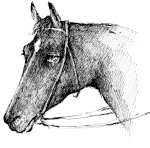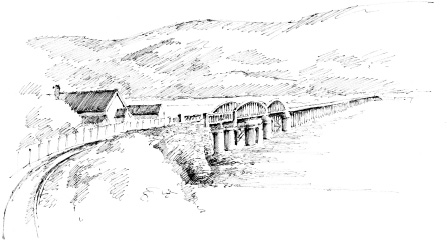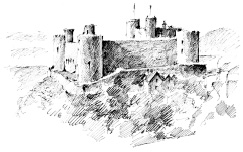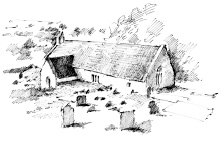
Portmeirion – Italy comes to Wales
THE OLD COUNTY town of DOLGELLAU lies in the shadow of Cader Idris at the head of the Mawddach estuary. Its streets are dark and narrow, lined mainly with Georgian houses, and there is a lovely bridge of seven arches dating from 1638. The 18th-century church of St Mary has rare oak pillars. Dolgellau has long been at the centre of the Welsh gold trade. The Romans came here for gold and so did the Victorians, and the Clogau Gold Mine in Bontddu, near Barmouth, was at one time producing three-quarters of all the gold in Britain.
Welsh gold has been mined since prehistoric times. It is known for its unique ‘rose’ hue and has always been highly sought after. Celtic craftsmen fashioned exquisite gold items, and Welsh princes would display gold jewellery to show off their wealth and power. For over a hundred years royal wedding rings have been made from Welsh gold, a tradition begun by the future George V and Queen Mary when they married in 1893, and continued by the Queen Mother, Elizabeth II, Princess Diana and the Duchess of Cornwall. Hollywood actor Michael Douglas bought himself one to celebrate his marriage to Catherine Zeta-Jones in 2000.
There never was a great quantity of Welsh gold, and in 2007 the last two gold mines of any substance, Gwynfynydd Gold Mine in Dolgellau and the Clogau Gold Mine, finally closed. Such scarcity serves to make Welsh gold THE MOST VALUABLE GOLD IN THE WORLD.
THE FFESTINIOG RAILWAY, running between Blaenau Ffestiniog in Merioneth and Porthmadog in Caenarfonshire, is THE OLDEST INDEPENDENT RAILWAY COMPANY IN THE WORLD. It was founded in 1832 to transport slate from the mines around Blaenau to the sea at Porthmadog, from where it was shipped around the globe. The line is 14 miles (22.5 km) long, with a track gauge of just 23 inches (58 cm), and drops 700 ft (213 m) from Blaenau to sea level at Porthmadog. The gradient was designed to be gentle and consistent, allowing full wagons to descend westwards by gravity alone, while the empty wagons could be hauled back up by horse.
The construction of a railway through such inhospitable terrain necessitated a raft of innovative engineering techniques. The rapid success of the Ffestiniog line brought engineers to Wales from all over the world, and Ffestiniog has had an influence on the design and construction of railways everywhere. The first steam engines were introduced in 1863, and in the same year Ffestiniog became THE FIRST NARROW-GAUGE RAILWAY IN THE WORLD TO CARRY PASSENGERS.
Painted bright red and still working the line is PRINCE, one of the original steam-engines built for the Ffestiniog railway in 1863. Prince is now THE OLDEST STEAM LOCOMOTIVE WORKING IN REGULAR SERVICE IN THE WORLD.

Another innovation pioneered on the Ffestiniog line was a double bogie engine, back-to back-locomotives articulated in the middle, designed by Robert Fairlie to provide more power for climbing the gradient and taking sharp curves. The Fairlie ‘Little Wonder’ was first demonstrated in 1870, and a number of Double Fairlies are still in service on the line today.
Just north of the station at Tan-y-Bwlch the line runs past a little cottage built in 1873 for a railway inspector. There is a tiny platform here where the train will stop on request for walkers to alight. Between the wars the cottage was rented out as holiday accommodation, and amongst those who stayed there were St John Philby, father of Stalinist spy Kim Philby, and William Joyce, the treacherous Lord Haw-Haw, who mentioned the cottage in several of his infamous wartime propaganda broadcasts for the Nazis.
The name of the cottage is COED-Y-BLEIDDIAU, or ‘The Wood of the Wolves’, and is reputed to be near the place where THE LAST WOLF IN WALES WAS KILLED.
The trip from Porthmadog to Blaenau runs through some of the most ravishing scenery in the world, but entering BLAENAU FFESTINIOG is like going back to black-and-white television after colour. Everything is a shade of grey. Grey slates, grey mountains, grey houses, grey sky – Blaenau is pretty much the greyest and the wettest town in Wales. It is all terribly bleak, and yet that very bleakness seems to attract artists and writers from everywhere, keen to ‘get away from it all’.
The controversial Hungarian writer and political commentator ARTHUR KOESTLER lived in a farmhouse called Bwlch Iccyn, near Blaenau Ffestiniog, for a number of years, after the end of the Second World War.
The overlooked but talented writer JOHN COWPER POWYS spent the last eight years of his life in Blaenau, having fled here after finding his home town of Corwen had become ‘too crowded’.
Internationally renowned sculptor DAVID NASH has lived and worked in Blaenau Ffestiniog for 40 years, and the multi-talented artist FALCON D. HILDRED has converted an old watermill in Blaenau into a studio and exhibition space.
During the Second World War pictures from the royal art galleries and the Tate and National Galleries were transported to Blaenau Ffestiniog in disguised delivery vans, for storage in the tunnels and caves of the Manod Quarry, 1,000 ft (300 m) below the summit of the mountain. The storage caves were specially heated and ventilated to protect the priceless paintings from damp and cold.
Today, you can visit two of the slate-mines, LLECHWEDD SLATE CAVERNS and GLODDFA GANOL, once THE LARGEST SLATE-MINE IN THE WORLD.
THE BALA LAKE RAILWAY runs alongside BALA LAKE, OR LLYN TEGID, THE LARGEST NATURAL LAKE IN WALES. Four miles (6.4 km) long, nearly 1 mile (1.6 km) wide and up to 150 ft (46 m) deep, the lake is of great ecological importance, rich in unusual plants, fish and bird life. Bala Lake is the only lake in Britain where you can find the reclusive GWYNIAD, a kind of freshwater herring that lives in deep water and feeds on plankton. Rarely seen, the gwyniad cannot be caught with a rod, as it is not attracted by any normal bait, and has to be netted.
The town of BALA, or Y Bala, sits at the head of the lake to the north-east and consists largely of one long, tree-filled street, lined with shops, municipal buildings and chapels.
Outside the Methodist Capel Tegid is a statue of THOMAS CHARLES (1755–1814), the Methodist preacher who was inspired to help create THE BRITISH AND FOREIGN BIBLE SOCIETY, in 1804, by the courage and determination of a schoolgirl called MARY JONES.
Mary Jones was a weaver’s daughter who lived with her parents in the remote mountain hamlet of Llanfihangel-y-Pennant, on the southern slopes of Cader Idris, and attended the school at Abergynolwyn which Thomas Charles had founded. At the age of ten she started to save up for her own Welsh bible, something very scarce in the rural community where her home was. It took her six years to save the money, selling eggs and honey and doing chores on the nearby hill farms.
One morning in 1800, when she had saved enough, she set off across the mountains, alone and barefoot, to call on Thomas Charles in Bala, 25 miles (40 km) away, and to buy a bible from him. When she got there, exhausted and hungry, Thomas Charles had to tell her that he had no bibles left, that they were all sold and the printers were refusing to print any more. Mary was devastated, and Charles was so moved by her devotion and commitment that he gave her his own bible, and determined that from that time on anyone who wanted a bible in their own language should have one, no matter what.
A monument to Mary stands in the ruins of her family’s cottage in Llanfihangel-y-Pennant.
Another celebrated resident of Bala was MICHAEL D. JONES, a Nationalist and Nonconformist preacher who was the inspiration behind the Welsh community in Patagonia, in what is now Argentina. His idea was to create an independent Welsh community away from the interference of the English, where they could run their own affairs, speak their own language and practise their own religion. Australia, New Zealand and even Palestine were considered, but an offer by the Argentinian government of 100 square miles (259 sq km) of virgin territory along the Chubut River in Patagonia seemed too good an opportunity to pass up.

Having received good reports of the area from prospectors Lewis Jones and Sir Love Jones-Parry of Madryn (see Caernarfonshire), Michael Jones raised the finance and found the volunteers, and, in May 1865, the good ship Mimosa sailed away from Liverpool with 153 brave souls aboard, to found a free Welsh paradise on the other side of the world. After much hardship and struggle the community established itself and still exists today. Although fully integrated with the Spanish now, there are still Welsh speakers amongst the descendants of the original settlers, and Welsh culture is kept alive with Welsh chapel services and a yearly eisteddfod. On the seafront in Puerto Madryn there is a monument at the spot where the Mimosa landed, showing the first immigrants with their bibles.
BURIED IN HIS pyramid-crowned family mausoleum at the top of the churchyard in Llanfor, half a mile (0.8 km) outside Bala, is RICHARD JOHN LLOYD PRICE (1843–1923). He was saved from financial ruin when his race horse Bendigo won the Cambridgeshire, and his epitaph reads:
‘As to my latter end I go,
To win my Jubilee,
I bless the good horse Bendigo,
Who built this tomb for me.’

Lloyd Price was the squire of RHIWLAS, a fine house in the hills above Bala, since rebuilt by Clough Williams-Ellis in 1951. As a sportsman Price didn’t just love horses but dogs too, and in 1873 he inaugurated THE FIRST MODERN SHEEP-DOG TRIALS on his land at Rhiwlas.

He also pioneered the distilling of Welsh Whisky, and in 1887 he opened a huge distillery on the River Tryweryn at Fron Goch, just up the road, which produced ‘the most wonderful whisky that ever drove the skeleton from the feast or painted landscapes on the brain of man’, according to his publicity. Unfortunately the enterprise went bust in 1910, and at the start of the First World War the distillery buildings were requisitioned by the government as a prisoner-of-war camp. After the 1916 Easter Rebellion hundreds of Irish republicans were interned at Fron Goch, including key figures such as Terence MacSweeney, J.J. O’Connell and Michael Collins. There is a monument to those times by the roadside, written in English, Welsh and Gaelic.

OVERLOOKING THE FUNFAIR and amusement parks of sunny Barmouth is DINAS OLEU, the ‘Fortress of Light’, THE FIRST POSSESSION EVER GIVEN TO THE NATIONAL TRUST. This 4½ acres (1.8 ha) of gorse-covered hillside was donated in 1895 by a wealthy resident who lived nearby, Mrs Fanny Talbot, and marks the start of the heavenly Panorama Walk across the hills of the Mawddach Valley. It can be easily reached from the main street in Barmouth via a footpath.
Down by the beach is Barmouth’s oldest building, TY GWYN, an ancient house dating from 1460 and used as a meeting-place for supporters of Harry Tudor and the House of Lancaster.
The centre of Barmouth is dominated by the church of St John the Evangelist, built in 1898, and paid for by Mrs Perrins of Lea & Perrins sauce fame. In the 1880s the Perrins family built themselves a substantial holiday home at Barmouth called Plas Mynach, set in its own grounds, with wide views over the sea and the Mawddach estuary. Barmouth has left such genteel Victorian days behind, and now goes in for more robust pleasures.
Since 1977 Barmouth has been the starting line, on midsummer’s day, for the annual THREE PEAKS RACE, in which competitors attempt to sail to, and climb, the three highest peaks in Wales, Scotland and England – Mt Snowdon, Ben Nevis and Scafell Pike.
Spanning the Mawddach estuary is the magnificent BARMOUTH RAILWAY BRIDGE, built in 1867, over half a mile (0.8 km) long and made almost entirely of wood, except for a swing bridge section towards the Barmouth end, which hasn’t swung open since the 1960s. It was put there to allow boats in and out of the Mawddach estuary and used to be opened regularly to keep it in working order. Now nobody dares to open it again in case they can’t close it – which would be a shame for not only would it curtail the scenic train ride, but it would also close one of the most unique footpaths in Britain. The views, from the middle of the bridge, of the thickly wooded estuary and bare mountains are incomparable, and to stand above the gurgling water while the tide races out and the oyster-catchers bob and duck on the sandbanks is truly one of the wonders of Wales.


EVEN IN A country of such superlative panoramas as Wales, the view from the ramparts of HARLECH CASTLE is special. The awestruck visitor stands on a high wall, itself perched on a tall crag of rock – Harlech means ‘bold rock’ – and gazes across the shimmering sea to the gnarled, receding coastline of Lleyn. Laid out below, like a green and gold tapestry, the flat, sunlit marshes and sands of Morfa Harlech lead the eye across Tremadog Bay to the brooding, thunderous mass of Snowdon, one moment stark, proud and clear, the next veiled in dark and swirling clouds. Professor Tolkien must have been standing right here when he thought of Mordor. It is a view that holds you mesmerised, intimidated and elated.
Harlech is the best of castles to explore, with its dungeons, hidden passageways and spectacular walks around the battlements. A testing way to get to it is to climb the old harbour stairway clinging to the western rock face. Before the land where the golf course now is was reclaimed, waves used to lap against the foot of the rock, and when besieged, the castle could be supplied from the sea.
During the Wars of the Roses, Harlech Castle was a Lancastrian stronghold and held out under siege for seven years, until finally it fell to the Yorkists in 1468, a feat remembered in the song ‘Men of Harlech’. In the Civil War, Harlech was THE LAST ROYALIST CASTLE IN WALES TO SURRENDER TO OLIVER CROMWELL’S TROOPS.
A few miles south of Harlech, in the tiny village of Cefncymerau, near Llanbedr, is the ‘SALEM’ CHAPEL, THE MOST FAMOUS CHAPEL IN WALES. The interior is immortalised in an iconic painting by Sydney Curnow Vosper, showing a woman in traditional Welsh dress arriving late for morning service. Hidden deep in the folds of the woman’s cloak is an image of the Devil, designed to represent vanity, for it is thought that the woman arrived late, during the period of silence before the service, in order to make an entrance. The original was purchased by the 1st Viscount Leverhulme, the owner of Sunlight Soap, and he offered a free reproduction to anyone buying £7 of soap. The picture captures an appealing ‘Welshness’ and piety, and hangs on the wall of many a Welsh Nonconformist home. The model for the woman in the picture was SIAN OWEN (1837–1927), buried in the churchyard of St Mary’s in Llanfair, just up the road.
IT SHOULDN’T WORK, but it does. There is no more romantic place in Wales than PORTMEIRION, and it is hard not to fall under its spell. This is the culmination of the life’s work of SIR CLOUGH WILLIAMS-ELLIS (1883‒1978). The beauties of the landscape enhanced rather than spoilt, man and nature clasped together in perfect harmony. The setting could not be more spectacular: a sheltered hillside on Tremadog Bay, with sea and woods and cliffs, and a purple backdrop of mountains.
Touring Italy in the 1920s, Williams-Ellis had fallen in love with the Mediterranean fishing village of Portofino, and he returned home determined to recreate that special atmosphere in his own homeland. After a lengthy search he settled on an untamed, derelict scrap of land between Porthmadog and Harlech, and transformed it into an Italianate extravaganza. Grouped around a central piazza are domes and campaniles, statues and fountains, boxed windows and weather boarding, clocks and colonnades, all bedecked with shrubs and flowers and trees. Portmeirion took Clough Williams-Ellis 50 years to complete, and it looks as if it has been there 500 years.
The distinctive Portmeirion pottery was established in 1960, by Clough Williams-Ellis’s daughter Susan, who fashioned and created the original designs, inspired by the beauties of Portmeirion village. She and her husband Euan took over a pottery business in Stoke on Trent to manufacture the pottery, which is now exported all over the world.
NOËL COWARD wrote Blithe Spirit during a two-week stay at Portmeirion in 1941, after his London office had been destroyed in the Blitz.
In 1966–67 Portmeirion became ‘The Village’ in the cult television series THE PRISONER, starring Patrick McGoohan.
Among other television series that have featured Portmeirion are Doctor Who, Citizen Smith, Brideshead Revisited and Cold Feet.
On the cliffs above the village there are trails through a subtropical woodland known as Y Gwyllt, literally ‘the wild place’, with rhododendrons, camellias, Californian redwoods, New Zealand dancing trees and THE TALLEST CHILEAN MAITEN TREE IN BRITAIN.
Walk across the wide, open sands of Traeth Bach in the twilight, while the distant waves of Tremadog Bay pound on the wind at your back, the estuary gleams in the pale light of the rising moon, and the twinkling domes of Portmeirion beckon out of the dusk, and just for a moment, you really could be in Paradise.
Wales is known for its ‘great little railways’ and Merioneth has four of the best, the Bala Lake, the Ffestiniog, the Talyllyn and the Fairbourne.
A ferry ride across the estuary from Barmouth is WALES’S SMALLEST NARROW-GAUGE RAILWAY, with a gauge of just 12¼ inches (31 cm). The FAIRBOURNE STEAM RAILWAY runs for 2½ miles (4 km) from the dunes of Penryhn Point to Fairbourne Village. The track was laid in 1895 by Sir Arthur McDougall of McDougall’s flour, to transport building materials for the new beach resort at Fairbourne. The station by the golf club boasts THE LONGEST PLACE NAME IN BRITAIN, Gorsafawddachaidraigddanheddogleddollonpenrhynareurdraethceredigion, meaning ‘The Mawddach station and its dragon teeth at the Northern Penrhyn Road on the golden beach of Cardigan Bay’. This beats the station name at Llanfair PG on Anglesey by nine letters. The folk at Llanfair PG complain that the Fairbourne name was just manufactured to get into the Guinness Book of Records, and this is true, but then Llanfair PG was also concocted to attract the tourists. So, you take your pick. They are both in the Guinness Book of Records.

THE TALYLLYN RAILWAY was opened in 1866 to carry slate from the Bryn Eglwys quarry to the Cambrian railway line at Tywyn, and runs for 7 miles (11 km) along the beautiful Afon Fathew valley from Tywyn to Abergynolwyn. After the quarry closed in 1947, and the railway was no longer viable, a group of enthusiasts got together to run the line as a tourist attraction, and in 1951 they formed THE WORLD’S FIRST RAILWAY PRESERVATION SOCIETY.
Reaching a height of 1,790 ft (546 m), the BWLCH-Y-GROES PASS linking Bala with Dinas Mawddwy is the HIGHEST ROAD IN WALES.
ST CADFAN’S CHURCH in TYWYN, remarkable for its enormous, solid Norman nave, also possesses a gravestone with THE EARLIEST KNOWN INSCRIPTION IN THE WELSH LANGUAGE. The tall stone pillar dates from the 8th century and is thought to read, ‘The body of Cingen lies here’. It was discovered in a nearby field, being used as a gatepost.
Buried under a yew tree in the lonely churchyard at LLANFIHANGEL-Y-TRAETHAU, north of Harlech, is RICHARD HUGHES (1900–76), author of A High Wind in Jamaica. His 1924 play Danger was THE FIRST PLAY TO BE BROADCAST ON RADIO. Also lying in the same churchyard is WILLIAM DAVID ORMSBY-GORE, 5TH LORD HARLECH, British Ambassador in Washington during the Kennedy years.

St Cadfan’s Church
Writer and philosopher BERTRAND RUSSELL (1872–1970), lived in a house called Plas Penrhyn, in Penrhyndeudraeth, for the final years of his life. He won the Nobel Prize for Literature in 1950 and was the inaugural recipient of the Jerusalem Prize, an award for writers interested in the freedom of the individual in society.
One of the most restful places in Wales lies just along the River Dee from Corwen, where two simple churches stand peacefully almost side by side in fields. LLANGAR CHURCH, or Llangaewgwyn, meaning Church of the White Stag, was built on the spot where a white stag appeared to some villagers who were praying in the open air. It has a single nave, a fine medieval roof and some faded wall paintings. The other church, called Y RUG, once the private chapel of Colonel William Salusbury (1580–1660), sits in grounds laid out later by Humphry Repton. The plain exterior hides an interior rich with wood carvings, canopied pews, ornate bench ends and a wonderful gallery.
The whole problem with the world is that fools and fanatics are always so certain of themselves, but wiser people so full of doubts.
Few people can be happy unless they hate some other person, nation or creed.
The desire to understand the world and the desire to reform it are the two great engines of progress.
Quotes from Bertrand Russell

Five miles (8 km) from Portmeirion, in Llanfrothen, is PLAS BRONDANW, where Sir Clough Williams-Ellis lived until his death in 1978. The magnificent gardens he laid out around the house are now open to the public.
The distinctive shape of BIRD ROCK, CRAIG-YR-ADERYN, soars 760 ft (232 m) over the water-meadows of the Dysynni valley. Bird Rock is a sea cliff that was left stranded, 4 miles (6.4 km) inland, when the sea retired behind a new spit of sand. The local cormorants have yet to accept that the sea has gone and continue to nest on the rock – making it THE ONLY INLAND CORMORANT NESTING SITE IN BRITAIN.

In the middle of the village of TRAWSFYNYDD there is a statue of ELLIS HUMPHREY EVANS, born here in 1887. He was a shepherd and a poet, and he won the chair at the Eisteddfod of 1917, held that year in Birkenhead. When the winner’s name was announced, it was discovered that Evans had died in the trenches in Flanders. His chair was draped in black and became known as the Black Chair of Birkenhead. The vast and sinister concrete blocks of the now decommissioned Trawsfynydd Power Station loom incongruously over the trees – it is THE ONLY NUCLEAR POWER STATION EVER TO BE LOCATED IN THE MIDDLE OF A NATIONAL PARK (Snowdonia).
Eight miles (13 km) south of Dolgellau, in an abandoned slate quarry, is Europe’s leading Eco village, the CENTRE FOR ALTERNATIVE TECHNOLOGY. The site is almost self-sufficient: they grow their own organic foods, and energy is drawn from windmills, water-powered generators and solar panels. A unique water-balanced railway, similar to those used in the old slate quarries, carries passengers 180 ft (55 m) up the hillside.